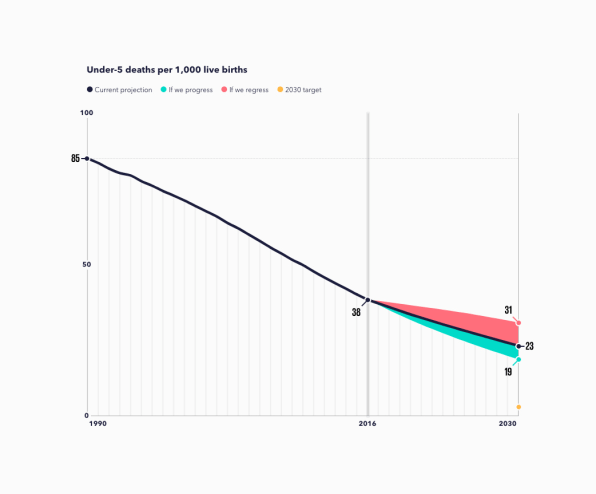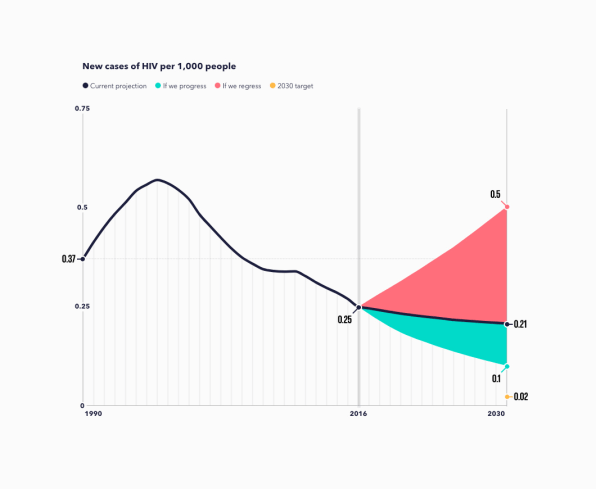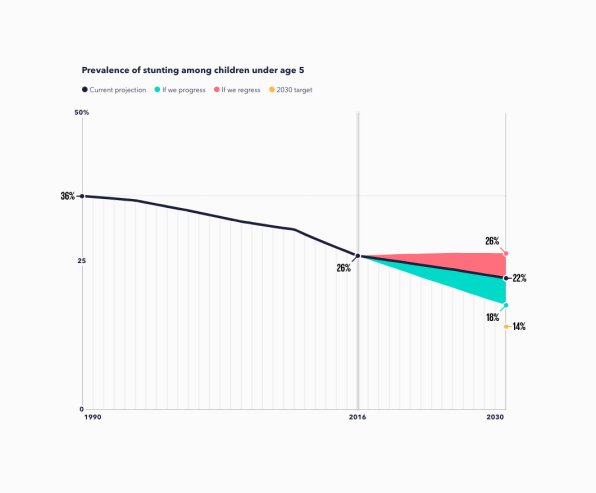Visualizing The True Impact Of The Sustainable Development Goals
In September 2015, nearly 200 world leaders agreed to work toward the UN’s Sustainable Development Goals, a set of universal quality of life targets that, if met, could eradicate extreme poverty and racial injustice and greatly reduce the impact from climate change by 2030.
Two years later, there’s been some progress, but as many countries, including the U.S. shift toward nationalistic and isolationist ideologies, there’s another global threat: that some of those commitments toward funding and researching solutions will be withdrawn.
To keep everyone accountable, the Bill and Melinda Gates Foundation has partnered with the Institute for Health Metrics and Evaluation at the University of Washington to release its inaugural Goalkeepers report, which will be published annually to show whether progress toward the global goals is continuing.
In one way, it’s an incentive: “It’s hard sometimes for people to see the progress because they see how different and how tough conditions are in poor countries,” Bill Gates notes in the introductory video below. But it is also intended to be a gut check: “This year and every year, we, the Gates Foundation… will share what we think is working and be honest about what’s not,” adds Melinda in the video.
In Angola, the report notes, children are 75 times more likely to die than in a more developed country like Finland. Child mortality is an issue that many developing countries, including Nigeria, Democratic Republic of Congo, and Pakistan struggle to fix. In contrast, Malawi has dramatically reduced its early death toll from one in four kids in 1990 to about one in 16 today, by teaching medical officials modern resuscitation techniques, outfitting clinics with inexpensive antiseptics to prevent infection, and encouraging mothers to breastfeed, which has been shown to boost children’s immunity to some diseases.
On a larger level, continuing to improve vaccine distribution networks in many places is crucial: “About 1.5 million of the children who will die next year, will die from diseases that we can prevent with vaccines,” notes the report.
So what will happen if more efforts aren’t ramped up or current levels of support decline? To answer that, the Gates Commission has designed a rough metric; it’s a calculation that extrapolates the current rate of change for various global goals like reducing childhood mortality, maternal death rates, and even smoking against what might happen if ostensibly more or less resources were committed, causing progress to shift toward either an above or below average pace of progress. (In this case, represented by the somewhat arbitrary 85th percentile of each issue’s historical change rate (when great leaps happen), compared to the 15th percentile (or when things drag), respectively.
The result is a series of visualizations that show whether current progress is enough, and how it might ideally progress or disastrously regress if that support waivers.
Take the UN target to end or dramatically reduce preventable deaths for children under 5. Success is set at 12 deaths per 1,000 kids. As chart below shows, though, just maintaining the current level of government support and investment isn’t really enough. Not only would the result be nearly twice above the (sort of) acceptable minimum, but any reduction in worldwide engagement would likely increase that number to 31 per 1,000. (Even the best case “if we progress” scenario of 19 per 1,000 comes up short, which should be a signal to everyone involved to generate more creative solutions.

In the case of HIV, continued or more progressive efforts should reduce infection rates even closer to total eradication. While currently fewer than 1 in 1,000 people worldwide are infected, losing focus on what’s working might actually cause that trend to reverse itself returning the disease to levels not seen since the year 2000, doubling the current infection rate to .5 cases per 1,000 people. The problem is that after huge global investment in preventative education and treatment practices about a decade and a half ago, there’s more competition to divert funds elsewhere because the “sense of crisis” has been so dramatically reduced, the report notes.

The same is true of diseases that have made great gains but not reached total annihilation, like malaria, tuberculosis, and neglected tropical diseases, all of which have been dramatically reduced in recent years but require a constant infusion of continued funding so that preventative measures–like, say, insecticide-treated bed nets for malaria hot zones–continue to be doled out.
Malnutrition is another huge concern because it causes stunting, a condition associated not just with shortened growth, but lifelong physical and cognitive problems for those affected. While the condition currently affects 26% of children under five, solving it involves a suite of health and nutritional interventions with a sustained and long-term commitment.

As more children develop normally, the argument goes, they’ll be able to be more productive, boosting their own life chances and local economies. It’s not a problem that may be solvable by 2030, but could be dramatically reduced to as low as 18%—and more if there are exponential breakthroughs (The UN has an entire accelerator program dedicated to this, and MacArthur Foundation just selected HarvestPlus, a group trying to fix local economies and their nutrition levels at the same time by enabling farmers to grow biofortified crops as a finalist in their competition that will award $100 million to make world-changing plans like that a reality.) Alternatively, leaders backing off any current commitments may cause progress to flat line completely.
For complex issues where such maladies combine to create a cycle of poverty, every last goal remains important. Same with the commitment to match successes with even more ambition.
Find the full progress report with charts here.
Fast Company , Read Full Story
(55)








